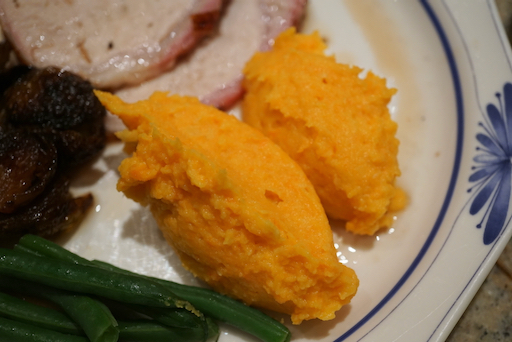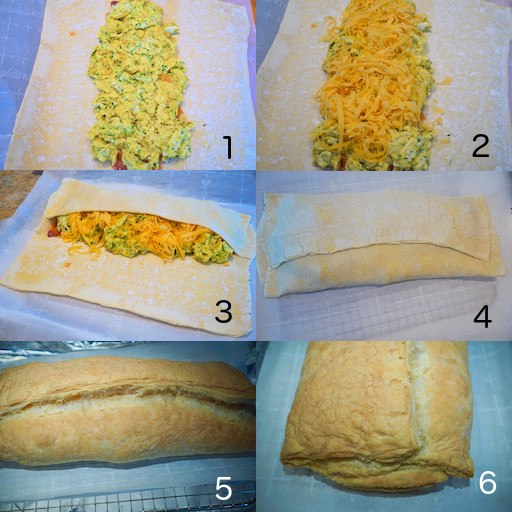This is a recipe my wife's sister sent us. It is one of those all-inclusive breakfast type dishes and we went for it. It is essentially a cream cheese omelet/scrambled egg with chives and dill and smoked salmon encased in puff pastry and baked. How could this be bad (at least in terms of taste rather than health).
We had this as a light lunch but it also goes well as a
hor d'oeuvres. The only problem was that the bottom crust did not quite puff up. Based on past experience with puff pastry we were afraid this would happen so we took some extra measures such as putting it on parchment paper and cooking it on a metal wire grate that elevated it above the baking sheet so the bottom could get more heat (see #5, composite picture below). The cut section shows nice layers of salmon and egg but, as can be seen, the bottom is not flaky. To remidy this my wife turned it upside down and toasted it in the toaster oven on high heat for several minutes. That did the trick the bottom puffed up nicely.
In making this we divided our labour. I made the eggs and my wife prepared the rest of the ingredients and assembled it.
Ingredients: (our modification).
1 frozen puff pastry sheet, thawed
4 eggs*
1/4 cup cream (original recipe calls for milk)
1/8 tsp salt
1 tsp butter
2 oz cream cheese (I used cream cheese with chives)
1/2 tsp chives, chopped (Original recipe calls for green onion)
2 tsp fresh dill, chopped
Smoked salmon, enough to cover center 1/3 of the puff pastry
1/2 cup Double Gloucester cheese (original recipe calls for Mozzarella, we did not have it).
*The original recipe called for 8 eggs. Although we used one sheet of puff pastry as indicated in the original recipe, we thought "8" eggs would be too much and reduced it to 4 eggs reducing the other ingredients accordingly. As you can see below 4 eggs are more than enough for one sheet of pastry (#3 and #4).
Directions:
The recipe said to preheat oven to 350F (we think 400F, is more appropriate. It is also the temperature called for in the instructions on the puff pastry box. At 350F the pastry was a bit too pale (#5 and 6) and the bottom did not cook completely).
Beat the eggs, add chives and dill, cream, and salt. Add small pieces of the cream cheese. In the non-stick frying pan, melt butter and add the egg mixture. Make loose scrambled egg/omelet.
Roll out the sheet of thawed puff pastry to 12 x15inches. On the center 1/3 place the smoked salmon leaving 1/2 inch on both ends, layer the eggs (#1) and the cheese (#2). Fold both sides (#3 and 4), brush with water (or as the original recipe suggests egg water) to seal the ends. Bake 25 minutes (#5 and 6).
Although we did not taste much of dill or chives, this is a very nice breakfast or snack with wine. After my wife re-toasted the bottom in the toaster oven, the eggs were encased in nicely puffed pastry. Initially the smoked salmon was quite assertive but still quite good. The whole dish got even better with time as the flavors melded together. It reheated nicely in the toaster oven. We will freeze some and see how we can reheat it. We'll have to work out a way to make sure the bottom also gets cooked because we will be making this again.
































